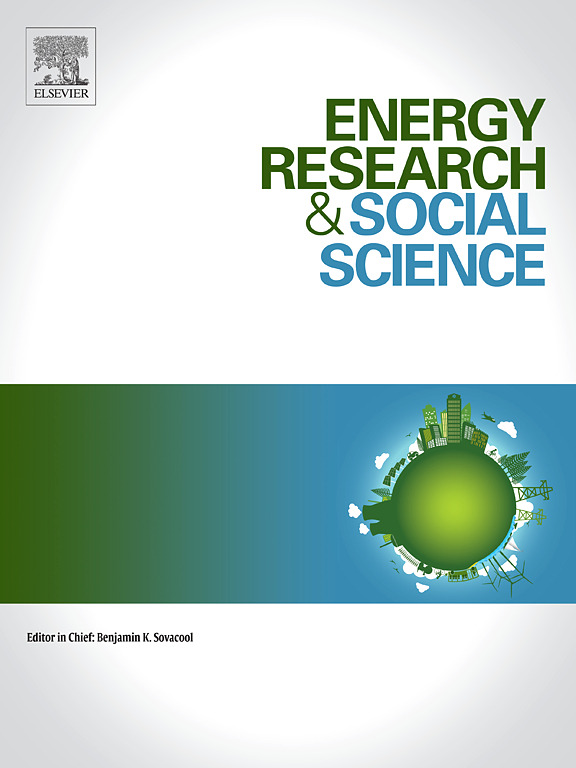Made in Australia, used in Asia: Public acceptance and the cable controversy of Australia-Asia PowerLink, a remote solar megaproject
IF 7.4
2区 经济学
Q1 ENVIRONMENTAL STUDIES
引用次数: 0
Abstract
To combat climate change, renewable energy projects must expand rapidly. This is increasingly achieved by expanding the size of projects. Through necessary changes in land use, very large projects increasingly trigger landscape-related and aesthetic concerns among the public, including competition with agricultural land and the transformation of familiar and traditional landscapes. More recently, solar megaprojects have been proposed in remote and sparsely populated locations. However, there is limited understanding of the public's level of acceptance and associated concerns for such megaprojects. We undertook an online survey (n = 2223) to assess the acceptance of a 12,000-ha large solar megafarm proposed for remote northern Australia, the Australia-Asia PowerLink project. We also assessed acceptance of associated infrastructure and of plans to export much of the energy to Asia via a 4200 km submarine cable. Although the proposed megafarm is double the size of any existing farm, public acceptance was very high, both of the farm itself (89 %) and the 800 km long overhead power lines required to transport the solar energy to its point of distribution (79 %). The level of acceptance was lower for the proposal to export most of the produced solar energy to a foreign country (54 %) and the construction of the submarine cable needed to do so (65 %). The results suggest concerns among the Australian public for distributional justice even if the rural location of the proposed solar farm is considered favourably.
澳大利亚制造,亚洲使用:澳大利亚-亚洲电力连接的公众接受和电缆争议,一个偏远的太阳能大型项目
为了应对气候变化,可再生能源项目必须迅速扩大。这可以通过扩大项目规模来实现。通过土地用途的必要改变,大型项目越来越多地引发公众对景观和美学的关注,包括与农业用地的竞争以及熟悉和传统景观的转变。最近,在偏远和人口稀少的地区也提出了大型太阳能项目。然而,人们对公众对这些大型项目的接受程度和相关担忧的了解有限。我们进行了一项在线调查(n = 2223),以评估为偏远的澳大利亚北部提议的12,000公顷大型太阳能发电场的接受程度,即澳大利亚-亚洲电力连接项目。我们还评估了相关基础设施的接受程度,以及通过一条4200公里的海底电缆向亚洲出口大部分能源的计划。尽管拟议中的巨型农场的规模是现有农场的两倍,但公众的接受度非常高,无论是农场本身(89%),还是将太阳能输送到配电点所需的800公里长的架空电线(79%)。接受度较低的是将大部分生产的太阳能出口到国外(54%)和建设海底电缆(65%)的建议。研究结果表明,即使拟议中的太阳能发电场的农村位置被认为是有利的,澳大利亚公众也担心分配公平。
本文章由计算机程序翻译,如有差异,请以英文原文为准。
求助全文
约1分钟内获得全文
求助全文
来源期刊

Energy Research & Social Science
ENVIRONMENTAL STUDIES-
CiteScore
14.00
自引率
16.40%
发文量
441
审稿时长
55 days
期刊介绍:
Energy Research & Social Science (ERSS) is a peer-reviewed international journal that publishes original research and review articles examining the relationship between energy systems and society. ERSS covers a range of topics revolving around the intersection of energy technologies, fuels, and resources on one side and social processes and influences - including communities of energy users, people affected by energy production, social institutions, customs, traditions, behaviors, and policies - on the other. Put another way, ERSS investigates the social system surrounding energy technology and hardware. ERSS is relevant for energy practitioners, researchers interested in the social aspects of energy production or use, and policymakers.
Energy Research & Social Science (ERSS) provides an interdisciplinary forum to discuss how social and technical issues related to energy production and consumption interact. Energy production, distribution, and consumption all have both technical and human components, and the latter involves the human causes and consequences of energy-related activities and processes as well as social structures that shape how people interact with energy systems. Energy analysis, therefore, needs to look beyond the dimensions of technology and economics to include these social and human elements.
 求助内容:
求助内容: 应助结果提醒方式:
应助结果提醒方式:


